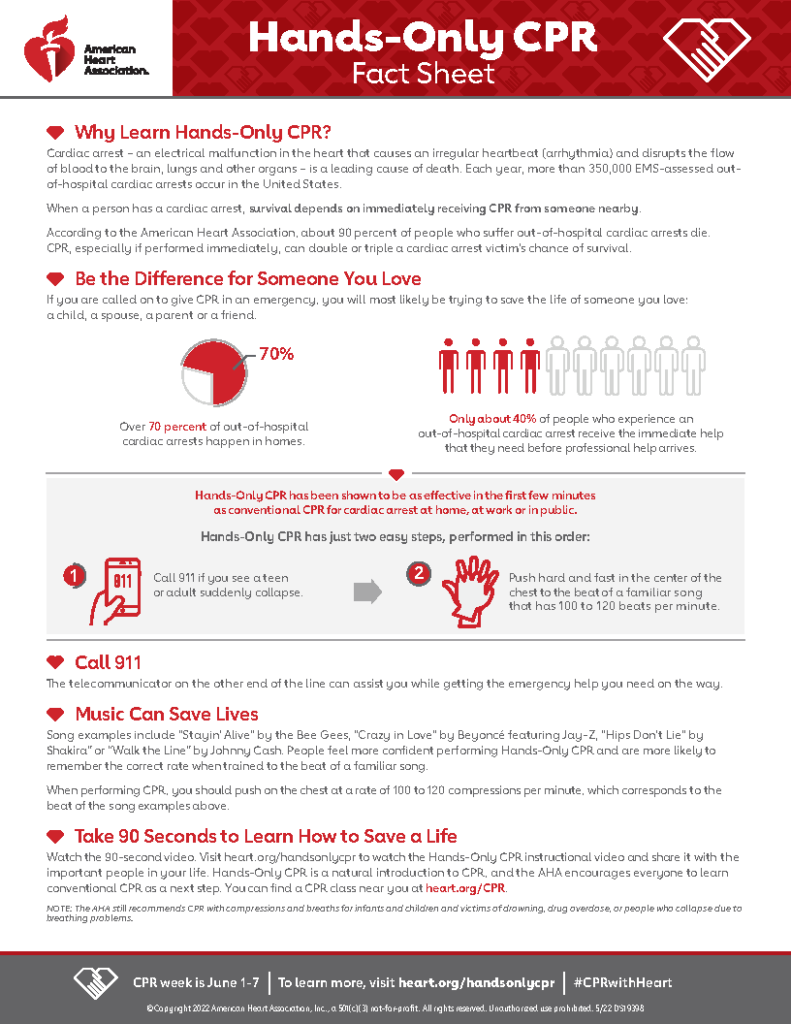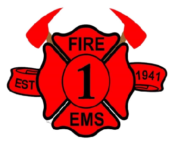Public Education
FOR EMERGENCIES PLEASE CALL 911
CPR and AED Training and Resources
What is Hands-Only CPR?
Hands-Only CPR is when Cardiopulmonary Resuscitation (CPR) is performed without the mouth-to-mouth rescue breaths.
Why Would you use Hands-Only CPR?
With 70 % of all out-of-hospital cardiac arrests happening at home, if you’re called on to perform Hands-Only CPR, you’ll likely be trying to save the life of someone you know and love. Hands-Only CPR carried out by a bystander has been shown to be as effective as CPR with breaths in the first few minutes during an out-of-hospital sudden cardiac arrest for an adult victim.
Does learning Hands-Only CPR increase the chance of a bystander taking action in a cardiac emergency?
Yes. Most Americans (70 %) feel helpless to act during a cardiac emergency because they don’t know
how to administer CPR or they’re afraid of hurting the victim. According to the American Heart Association,
people are more likely to remember the correct pace when trained to the beat of the disco classic “Stayin’
Alive” or another familiar song with 100 to 120 beats per minute – the rate you should push on the chest during
CPR.
Watch the video below to learn how to perform Hands-only CPR.
WATCH THE VIDEO BELOW TO LEARN HOW TO USE AN AUTOMATED EXTERNAL DEFIBRILLATOR (AED)

FEMA Bystander Training
Are you the HELP until HELP arrives?
Life-threatening emergencies can happen fast and emergency responders aren’t always nearby. You may be able to save a life by taking simple actions immediately.
According to the Center for Disease Control (CDC), trauma is the leading cause of death for Americans under age 45. Life-threatening injuries require immediate action to prevent an injured person from dying. Those nearest are best positioned to provide first care. FEMA offers a quick web-based video on how, as a bystander, you can provide first care to potentially save a life. Click the link to take the training course FEMA Bystander Training Video.
5 Simple Steps That May Save a Life
First Care Focuses on Five Essential Actions
1. Call 9-1-1
2. Stay Safe
3. Stop the Bleeding
- Don’t assume someone else has already done so
- 911 operators are highly trained and will help you
- Let them coach you through the life-threatening situation
- Assess the situation: pause and use all available senses
- Decide whether to stay and help, grab the injured and get to safety, or get yourself to safety
- Apply steady, firm pressure on the source of bleeding until first responders arrive
- If you can’t control the bleeding with manual pressure, consider a tourniquet
4. Position the Injured
5. Provide Comfort
- Lay the injured on their side, legs slightly bent, with bottom hand reached outward and head resting near hand
- Raise the chin forward with mouth pointed downward
- Share names and ask basic questions
- Tell them what you know happened, but do not speculate
- Keep them warm and offer a hand to hold
Community Emergency Response Team (CERT)
The Community Emergency Response Team (CERT) program educates volunteers about disaster preparedness for the hazards that may impact their area and trains them in basic disaster response skills, such as fire safety, light search and rescue, team organization, and disaster medical operations. CERT offers a consistent, nationwide approach to volunteer training and organization that professional responders can rely on during disaster situations, allowing them to focus on more complex tasks.
To learn more about CERT, visit https://www.ready.gov/cert.
